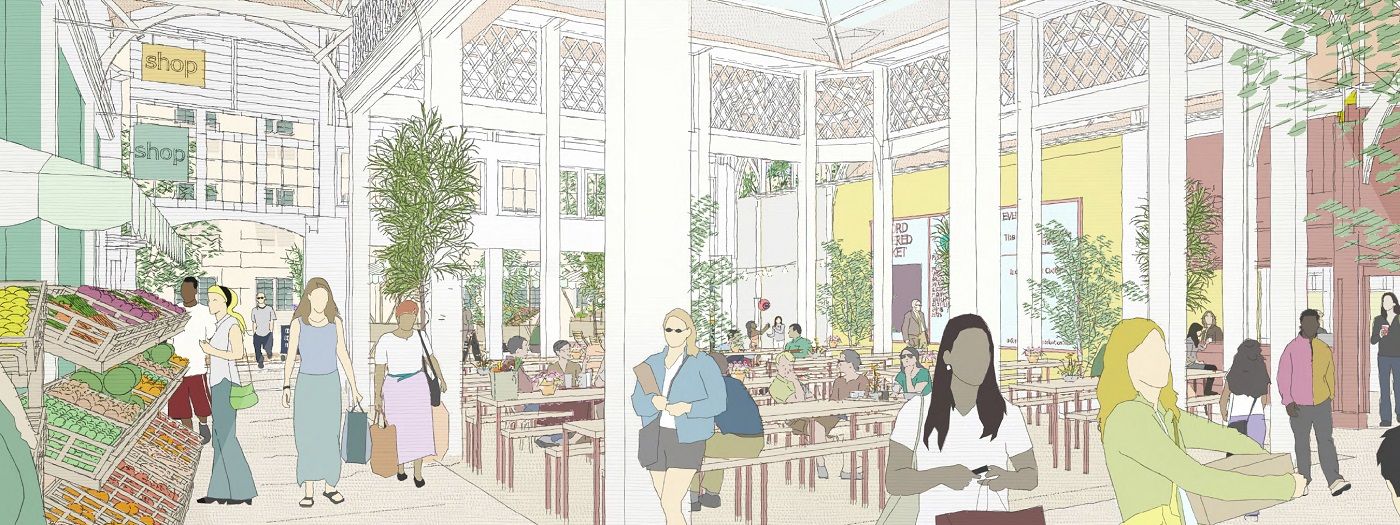Unexpected items in the roofing area: how DIY repairs scuppered the Covered Market

A series of unauthorised, unexplained and unusual fixes to the roof of Oxford’s Covered Market have led to a 4.5 year repair project stretching far beyond its projected completion date.
The Covered Market is owned and run by Oxford City Council. The council has drawn up two separate plans for the market. One was a “major repairs project to re-roof the entire covered market”, recognising that the complex multilevel roof – much of which dates back to the 18th century – was in urgent need of repair. The second was a regeneration project to improve the market’s layout and accessibility, particularly around the northern Market Street entrance.
It’s the second which has generated most of the headlines in this, the Market’s 250th anniversary year. But the roof repair project has proved unexpectedly complex – and controversial.
Mending the roof while the sun shines
In 2017, Oxford City Council issued a tender for repairs to the roof. The contract was awarded to Croft Building & Conservation, a well respected specialist firm, for £1.3m.
In 2018, the budget was increased to £1.7m “to allow for additional variations and contingencies”. Work began in January 2019, after the Christmas rush.
It soon became clear that all was not well with the roof.
Above what is now Colombia Coffee Roasters, a series of “modern-style skylights” had been installed without the City Council’s permission either as owner of the market or planning authority. These skylights had affected the structural integrity of the rafters and were causing leaks into the coffee shop below.
At the barber shop, an undocumented, unexpected – and leaking – internal gutter was discovered. Then, at Covered Arts, the original 18th century gutters were found to be too shallow, causing regular leaks within the shop – unwelcome news for any business, but particularly for a framing and gallery operation. In both cases, Croft’s repairs were complicated by the need to work around an operating business.
The slates on the roof of Avenue 4 (the southernmost aisle, home to Cardews tea and Browns Café) were found to be in exceptionally poor condition, and both the timber boards and the slates themselves required replacement.
Finally, the observant will have noticed that work got underway in 2019 – just before the pandemic shut down retail spaces everywhere. This forced a short break in work between late March and early May 2020, but equally significant was the disruption to global supply chains which affected supply of materials.
So what happened?
Croft completed the majority of the work, aided by a further increase in the project budget to £2.1m. But with this budget exhausted, the City Council were unable to authorise any further spending. Government procurement rules limit the increase allowed from the original budget before a new tender has to be issued.
The work came to a halt in September 2023. Two phases of work, which the City Council calls Phase 6c and Phase 7, were still to be completed. Croft’s site materials were finally removed earlier this year.
The new plan is for Phase 6c to take place as a separate contract this year, while the Phase 7 works will be incorporated into the regeneration project for the Market Street entrance.
Regeneration work

The artists’ impressions and concept design have caught the public eye – but as the roof repairs demonstrate, plans are one thing, implementing them on a 250-year old structure quite another.
Oxford City Council has now issued a tender notice for the redevelopment. They’re seeking a company which will carry out detailed design, project management, and all physical works. Crucially, the contract is described as “delivering the Oxford Covered Market masterplan including essential works” – a reference to the outstanding roof repairs.
The contract is worth £6.87m. Bids are expected by 26 April, with work starting in June 2024 to be complete by February 2030. In the brief, the City Council says:
The consultant team will need to demonstrate experience in revitalising historic markets including experience in heritage, planning, building and services works. This experience should include an understanding of the retail environment and the impact of such works from a business perspective.
Scribbler on the roof
Meanwhile, a low-level roof row rumbles on via Freedom of Information Act requests to Oxford City Council. Since summer 2023, one or more persistent individuals have been asking the council for details of the contracts and decision-making process around the roof repairs.
One particular inquirer, writing under the name Michel Giacobini, wryly called the refurbishment “Oxford's answer to the Sagrada Familia”, the Barcelona church under construction for 142 years. Although FOI requests are meant to be made under a real name, use of pseudonyms is widespread and it is likely that some questioners are writing under assumed names, ranging from a French astronomer to a Coronation Street actress. This is perhaps understandable: traders at the Covered Market are concerned about the integrity of the building, and yet anxious not to prejudice their relationship with their landlords, Oxford City Council.
In response to this flood of requests, numbering 29 so far, the City Council put together a briefing note saying “It is anticipated that as this is a detailed history of the project further officer time will not be spent on answering FOI requests.” So far, it has not stopped the FOI requests from coming in.
Oxford City Council says that “lessons have been learned” from the roof repairs:
The refurbishment project of the Covered Market has presented significant challenges and complexities particularly due to the unforeseen issues uncovered and experienced during the period from 2019 to 2023.
Despite the challenges faced, lessons have been learned from the work undertaken and the commitment to preserve this heritage asset and ensure the safety and integrity of the market’s structure remains a top priority for Oxford City Council.
